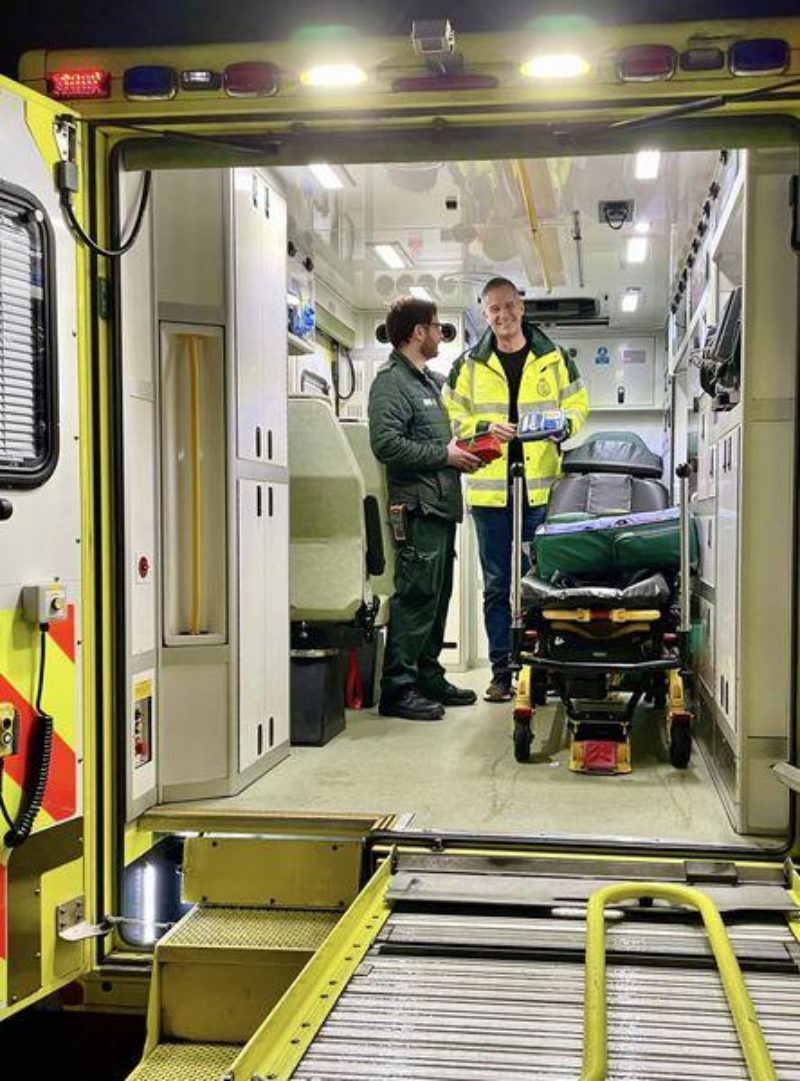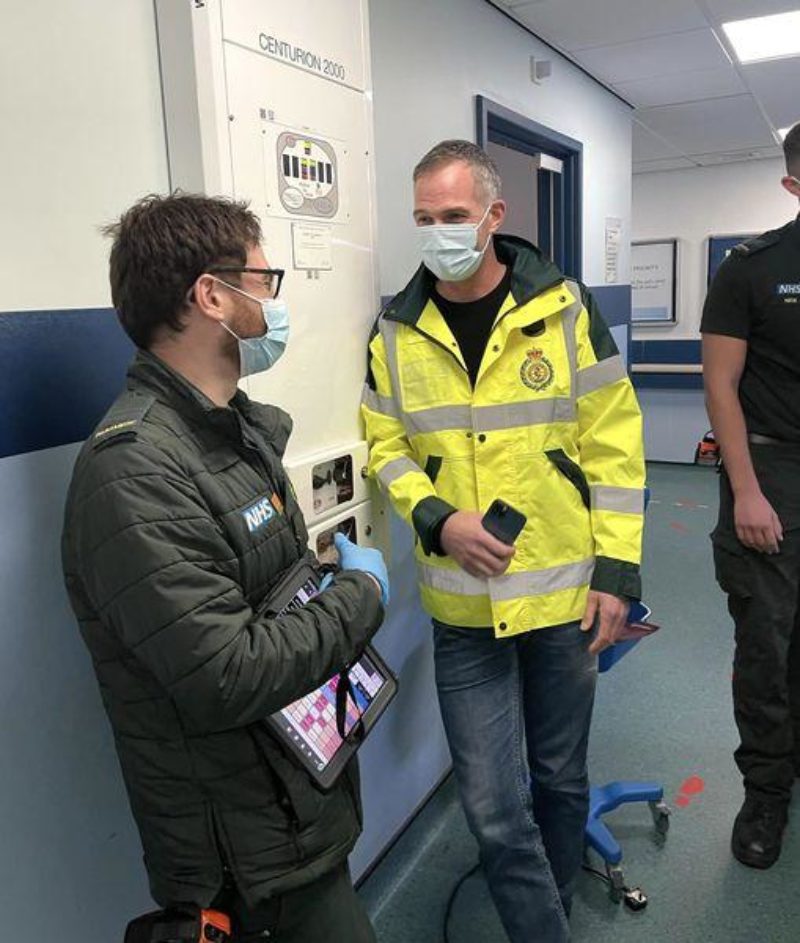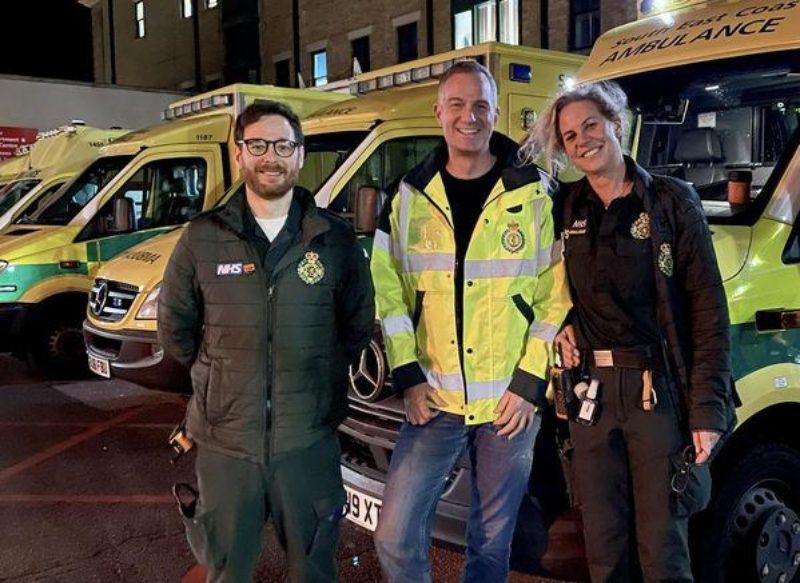Ambulances are in the news a lot right now so I’ve done a shift with a crew in Brighton and Hove so I can see what it’s like with my own eyes. Whenever I can find the time I try to spend it with frontline staff to understand better what it takes to keep communities safer, healthier and connected.
I spent the shift with Angelique and Ben, two highly experienced paramedics with SECAM, the ambulance service for our region. I have to say right now that having spent hours in their company zipping from one emergency to another, I’d feel very reassured if I were involved in an emergency and I saw their faces at the scene…they were just brilliant.
After touring the ambulance centre in Falmer to understand the people and technologies that go into supporting and directing their crews, I took to the road. We’d not even left the compound when the first call came in. Having travelled across town at speed (throughout the shift I never got used to shooting red lights, it just feels so wrong!) we arrived at what was a complex situation that required specialist equipment to be requested. Moving someone in pain, who is frightened, out of their home, out of a high-rise building and then transporting them to a hospital was a sensitive operation done with real skill.
Arriving at A&E was a real shock for me. A few people in recent months have described A&E as a ‘war zone’ and as soon as I walked in helping to push an unwell patient on a stretcher I realised what they meant. Let me be clear, I’m obviously not talking about poor standards or the walking wounded, but the thing about working in areas of emergency, which I did for some years, is that you just make do and there’s always a sense of being close to the point of being overwhelmed. That’s what I saw even though it was not considered an above-average day for A&E.
We parked the ambulance in the emergency bay, delicately lowered the patient from the vehicle, and wheeled her into the building and I was immediately struck by the sheer number of patients in that small space. The booths with paper curtains at one end were full, and so was another temporary area with perspex dividers. So was the corridor which had patients lined up along one wall.
We looked for somewhere to settle our patient in a process akin to trying to park a car on a busy street. Sometimes we passed a space wondering ‘could I squeeze into that’. We settled back where we started, right by the entrance door.
The Ambulance number was logged as we entered which triggered a time target to have the patient admitted. A little later I was shown the screen tracking all the ambulances present waiting to admit their patients. There were a couple highlighted in green, a few in amber, but most were red-coloured – I didn’t need the meaning of that explained to me.
You see, a vulnerable patient being brought by ambulance to A&E needs to be monitored at all times. Someone with the right training must have ownership of their situation. So until A&E staff have the capacity to admit the patient the ambulance crew must wait by their side. This took about 45 minutes for the first patient and about an hour and a half for the next.
So you start to see the problem. The system is very badly broken. A lot of people, perhaps a majority, of those turning up at A&E wouldn’t be there if the right measures were in place to prevent people with minor issues being allowed to develop into chronic ones, or had swift access to community-based doctors like GPs and walk-in clinics.

It’s the same for mental health, with a great deal of the younger people I saw in the hospital that day having acute mental health problems that really should be supported elsewhere in our community. So A&E, the front door to hospitals, is overcrowded. That means ambulance crews need to wait for hours at the bedside of patients and that means they’re not outside able to respond to new emergencies so the time it takes to get an ambulance grows and grows.
At the other end of the process, there’s another problem. When I spoke to the CEO of our hospital recently there were 57 patients cleared for discharge that day but none of them could leave because there weren’t any social care settings that would take them or care packages available to support people in their own homes. So they stay in the hospital, sometimes for weeks longer than they should.
So on one side, you have too many people going to A&E in the first place due to poor prevention and community-based health and on the other, too few people who are fit to leave the hospital are actually leaving. Right in the middle of that is A&E and the burden on those who work there just grows and grows.
In my mind, every person working in A&E and in our ambulance service is a hero. Bear this in mind too: the hospital wasn’t in crisis on the shift I worked, it wasn’t a particularly busy day by current standards. In fact, many of the staff were a little disappointed I didn’t see it at its most challenging!

I can’t tell you how wonderful and professional our medical and emergency staff are. One emergency we attended saw someone who’d suddenly collapsed in a public place despite having a good time with friends until then. We were there rapidly and people were gathered to support this person who was in and out of consciousness on the pavement. Calmly, and professionally the paramedics took control of the situation, stabilised the patient, and moved him through the stages from pavement to ambulance to hospital.
As you can imagine, going through something requiring an ambulance with blue flashing lights to arrive is pretty scary. I saw a lot of people who were so frightened about what was happening to them – having a health emergency is scary! And that’s what’s so remarkable about the people who chose to work in emergency medicine, not only are they great medics they’re also fantastic about protecting people’s dignity and caring for them too.
At one point in the evening, one person in our ambulance started to have a panic attack on top of the other issues that had led them to be attended to. Honestly, it’s really understandable considering how alarming a sudden and unexpected health crisis is. But despite all of the activity and testing and injections being carried out, one of the paramedics found the time to hold the patient’s hand, look them in the eye, and simply talk with calm, humane confidence giving clear instructions on breathing and things to focus the mind on. Within just a few moments everything stabilised and they could return to their pressured work and we were on our way – once more heading back to A&E.
Each time I returned to A&E I caught sight of previous patients as we were waiting to admit a new one. I popped over to speak to them and check they were ok. They were always so full of praise for the people but could see how stretched everything was and were worried about the next stages.
I was taken out of the ambulance arrival area and into the walk-in section of A&E. It was packed and appeared a little chaotic as so many people were standing – all the seats were taken.
I was struck by how many of the patients were elderly and how many of them were alone and had worry on their faces. A&E is a scary place to be a patient simply because of what people are experiencing to land them there in the first place. You only have to be there for a moment to see that our NHS is under huge strain and the system is clearly broken in places. We must, must solve the staffing crisis and get community health back onto its feet having been decimated by austerity and botched reforms. I’m pleased Wes Streeting, Labour’s shadow health secretary has launched a series of fully funded proposals to tackle just this.
Nurses have balloted for strike action for the first time in history. Ambulance staff have done the same. Money is important to them, of course, especially since the Tories blew a hole in our public finances. But it’s more than just money they’re drawing attention to, it’s about the system they’re working to which is placing an unbearable strain on them. I can tell you that we in Labour hear them loud and clear and will stabilise then grow our economy so we have an economy that delivers for everyone, and we’ll set about doubling the number of medical school training places and implementing our plan for the waiting list crisis.
I learned so much from my shift with Angelique and Ben and I’m grateful that they allowed me to come out with them on a busy evening. It’ll take time to fix the mess a future Labour government will inherit, but experiences like this have given me more determination than ever to make sure we at least get the chance – every future patient and paramedic is depending on it.
Yours, Peter

